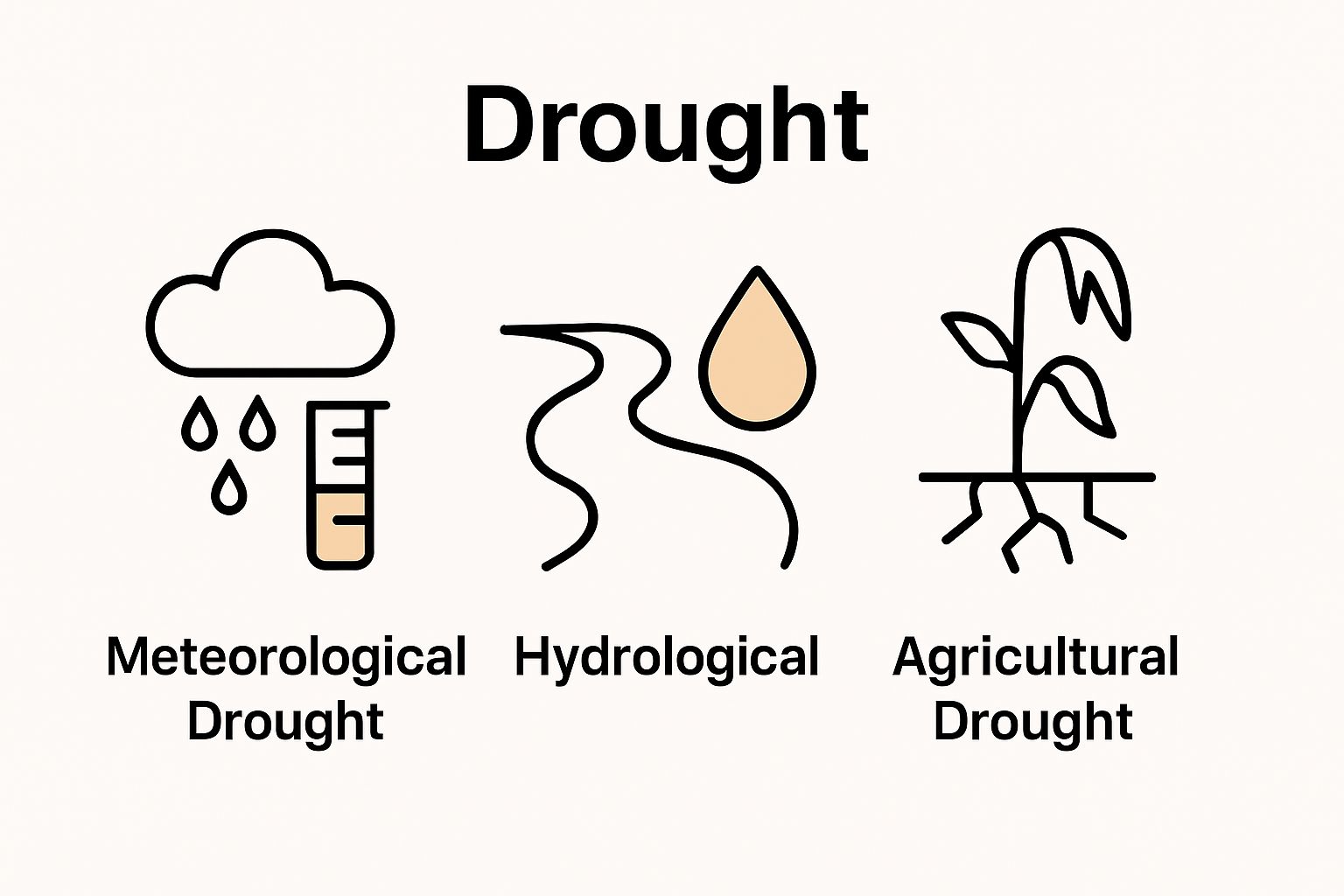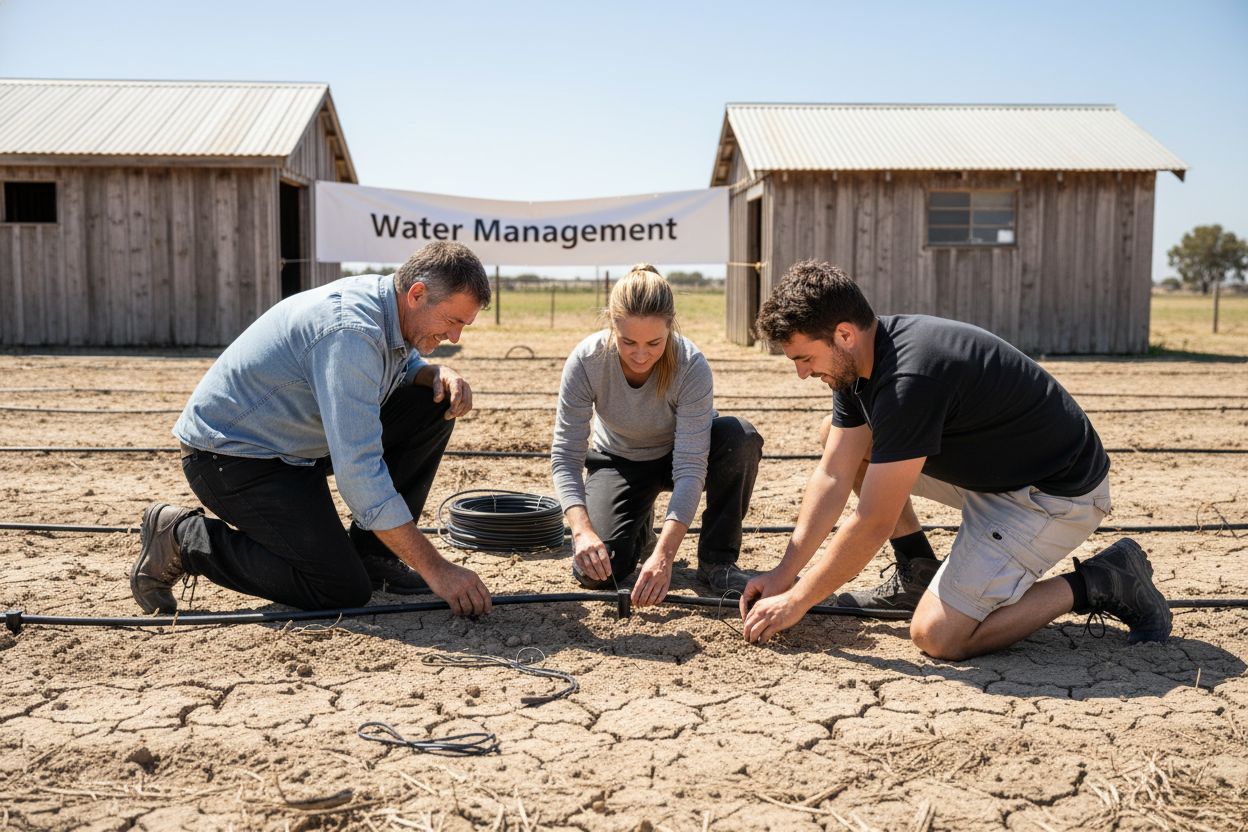Drought is more than just a dry spell for farmers. It has the power to upend entire harvests and livelihoods, with precision irrigation reducing water use by up to 50 percent compared to old flood irrigation methods. Most people think drought strikes fast like other disasters, but it actually creeps in slowly and does far more damage over time. The surprising part is that the real threat often comes from the tough decisions and strategic shifts that drought forces on every part of farming, not just the lack of rain.
Table of Contents
- What Is Drought And Its Impact On Agriculture?
- Why Drought Matters For Farmers And Ranchers
- How Water Management Practices Work During Drought
- Key Strategies For Protecting Crops And Livestock
- Real-World Examples Of Drought Adaptation
Quick Summary
| Takeaway | Explanation |
|---|---|
| Understand drought types | Familiarize yourself with meteorological, hydrological, and agricultural drought classifications for effective management. |
| Adopt precision irrigation | Utilize methods like drip irrigation to maximize water efficiency and reduce waste during dry periods. |
| Select drought-resistant crops | Prioritize planting varieties that thrive in low-water conditions to ensure productivity under drought stress. |
| Implement strategic livestock management | Provide supplemental feeding and shade to protect livestock from heat stress and maintain health during droughts. |
| Collaborate for water resources | Work with community water management to balance agricultural needs while supporting environmental sustainability. |
What is Drought and Its Impact on Agriculture?
Drought represents a prolonged period of abnormally low rainfall that significantly disrupts agricultural ecosystems and water availability. Unlike other natural disasters that occur suddenly, drought develops gradually, making its impact on farming operations complex and potentially devastating.
Understanding Drought Characteristics
At its core, drought is characterized by substantial precipitation deficits that persist over weeks, months, or even years. Agricultural experts classify drought into several critical categories:
- Meteorological Drought: Based on precipitation levels compared to long term average
- Hydrological Drought: Focuses on water system impacts like river levels and groundwater
- Agricultural Drought: Specifically examines soil moisture and crop growing conditions
These variations demonstrate how drought is not a simple binary condition but a nuanced environmental challenge with multiple dimensions affecting agricultural productivity.
The table below compares the three main types of droughts and highlights how each one impacts agricultural operations differently.
| Drought Type | Definition | Primary Agricultural Impact |
|---|---|---|
| Meteorological Drought | Below-normal precipitation compared to long-term average | Reduces available rainfall for crops |
| Hydrological Drought | Low water levels in rivers, lakes, and aquifers | Limits irrigation and water supply |
| Agricultural Drought | Insufficient soil moisture for crop needs | Hinders crop growth and field productivity |

Economic and Ecological Consequences
The impact of drought extends far beyond immediate water scarcity. According to National Drought Mitigation Center, agricultural drought can trigger substantial economic disruptions:
- Reduced crop yields
- Increased livestock feed costs
- Potential complete crop failure
- Significant financial strain on farming operations
Moreover, prolonged drought conditions force farmers to make critical strategic decisions about water conservation, crop selection, and understanding sustainable water management techniques.
Environmentally, drought disrupts entire ecological systems. Reduced rainfall leads to decreased soil fertility, increased soil erosion, and potential long term changes in regional agricultural landscapes. Farmers must adapt quickly, implementing sophisticated water management strategies and selecting drought resistant crop varieties to maintain agricultural productivity.
Why Drought Matters for Farmers and Ranchers
Drought represents an existential threat to agricultural operations, transforming routine farming challenges into potential economic catastrophes. While environmental disruptions impact all sectors, farmers and ranchers experience drought’s consequences most directly through immediate and long term productivity losses.
Economic Vulnerability of Agricultural Operations
The financial implications of drought extend far beyond temporary water shortages. According to NASA’s Climate Kids, agricultural professionals face substantial economic risks during prolonged dry periods:
- Dramatic reduction in crop yields
- Increased operational expenses for water procurement
- Higher livestock feed costs
- Potential complete agricultural income loss
These economic pressures can destabilize entire farming businesses, forcing difficult decisions about land use, livestock management, and financial survival.
Ecosystem and Production Impact
Drought fundamentally disrupts agricultural ecosystems, creating complex challenges that require strategic adaptation. Water scarcity triggers cascading effects across farming environments:
- Reduced soil moisture compromises crop germination
- Decreased vegetation limits grazing resources
- Higher temperatures accelerate plant water stress
Farmers must strategically prepare by understanding building windbreaks for agriculture and implementing comprehensive water conservation strategies. These proactive measures help mitigate drought’s most severe agricultural consequences, protecting both immediate productivity and long term sustainability.
Moreover, drought’s impact transcends individual farm operations. Regional agricultural communities experience systemic economic challenges, with reduced agricultural output potentially affecting local and national food security. Successful drought management requires collaborative approaches, integrating technological innovations, adaptive farming practices, and robust risk management strategies.
How Water Management Practices Work During Drought
Water management during drought requires strategic planning, advanced technologies, and adaptive agricultural techniques. Farmers must transition from traditional water use approaches to sophisticated conservation strategies that optimize every available water resource.
Precision Irrigation Techniques
Modern agricultural water management focuses on maximizing efficiency through precision irrigation methods. These advanced approaches minimize water waste while ensuring crops receive critical moisture during dry periods:
- Drip Irrigation: Delivers water directly to plant root zones
- Micro Sprinkler Systems: Provides targeted water distribution
- Sensor Based Monitoring: Uses technology to track soil moisture levels
According to United Nations Water Resources, precision irrigation can reduce water consumption by up to 50% compared to traditional flood irrigation techniques, making it crucial for drought resilience.
Strategic Water Resource Allocation
Successful drought water management involves complex decision making about resource prioritization. Farmers must evaluate multiple factors when allocating limited water supplies:
- Crop water requirements
- Current growth stages
- Predicted rainfall patterns
- Economic value of different crops
This strategic approach requires continuous monitoring and rapid adaptation to changing environmental conditions. Understanding land management strategies becomes essential for making informed water allocation decisions.
Additionally, water management during drought extends beyond immediate agricultural needs. Farmers increasingly collaborate with regional water management authorities, implementing comprehensive watershed protection strategies that balance agricultural requirements with broader ecological considerations. By adopting holistic water conservation approaches, agricultural professionals can build resilience against prolonged dry periods while maintaining productive farming ecosystems.

Key Strategies for Protecting Crops and Livestock
Drought demands proactive and comprehensive protective strategies for both agricultural crops and livestock. Farmers must implement multifaceted approaches that address immediate survival needs while maintaining long term agricultural productivity and economic sustainability.
Crop Protection Techniques
Successful crop protection during drought requires strategic interventions that minimize plant stress and preserve potential yields. Farmers can employ several critical techniques:
- Drought Resistant Crop Selection: Choosing plant varieties genetically adapted to low water environments
- Mulching: Preserving soil moisture and reducing surface evaporation
- Reduced Planting Density: Decreasing competition for limited water resources
- Early Harvest Strategies: Collecting crops before complete moisture depletion
These methods help agricultural professionals maintain some level of production during challenging environmental conditions.
Livestock Management Approach
According to Food and Agriculture Organization, protecting livestock during drought requires comprehensive management strategies:
- Providing supplemental feed with high nutritional density
- Creating shaded areas to reduce heat stress
- Maintaining clean water access points
- Implementing strategic breeding and culling practices
Farmers can read more about farm succession planning to understand how these challenging periods impact long term agricultural sustainability.
Additionally, drought protection extends beyond immediate survival. Successful farmers develop adaptive strategies that balance short term resilience with long term agricultural ecosystem health.
This table summarizes key drought adaptation strategies for both crops and livestock to help farmers protect their operations during prolonged dry conditions.
| Protection Area | Strategy | Purpose/Benefit |
|---|---|---|
| Crops | Drought-resistant crop selection | Maintain yields with less water |
| Crops | Mulching | Preserve soil moisture and minimize evaporation |
| Crops | Reduced planting density | Reduce competition for limited water |
| Crops | Early harvest strategies | Minimize losses before severe drought impacts |
| Livestock | Supplemental feed | Ensure adequate nutrition during forage shortage |
| Livestock | Shaded areas | Protect from heat stress |
| Livestock | Clean water access | Maintain animal health under water scarcity |
Real-World Examples of Drought Adaptation
Drought adaptation strategies demonstrate remarkable agricultural resilience, revealing how innovative farmers transform environmental challenges into opportunities for sustainable production. These real world examples showcase the creativity and determination required to maintain agricultural productivity under extreme conditions.
Innovative Crop Management Approaches
Successful drought adaptation often involves radical rethinking of traditional agricultural practices. Farmers have developed sophisticated strategies that go beyond conventional water conservation techniques:
- Intercropping: Planting multiple crop varieties that support each other’s water usage
- Regenerative Agriculture: Rebuilding soil organic matter to improve water retention
- Microclimate Engineering: Creating localized environments that reduce water stress
According to National Sustainable Agriculture Coalition, these approaches can increase agricultural resilience by up to 40% during prolonged dry periods.
Technological and Community Collaboration
Modern drought adaptation extends beyond individual farm operations, involving sophisticated technological interventions and community level coordination:
- Precision satellite monitoring of crop health
- Community water sharing networks
- Advanced predictive modeling for agricultural planning
Farmers can explore land management strategies to understand how technological innovations support drought resilience.
These examples demonstrate that drought adaptation is not about survival, but about transforming challenges into opportunities for more sustainable, efficient agricultural systems. By integrating advanced technologies, traditional knowledge, and collaborative approaches, farmers are redefining agricultural resilience in an era of increasing environmental uncertainty.
Protect Your Livelihood During Drought With Smart Solutions
Drought puts intense pressure on Canadian farmers and ranchers by threatening crops, livestock, and your hard-earned income. As highlighted in the article, water shortages and unpredictable rainfall can force you into tough choices about pasture management, animal feeding, and protecting your land’s long-term productivity. Reliable fencing and effective animal monitoring tools become essential to adapt quickly and keep your operation secure when the environment turns harsh.

Do not let drought dictate your success. Turn to FenceFast.ca for advanced electric fencing, livestock management tools, and animal health supplies that support resilience in dry conditions. Discover how our animal management solutions and expert guidance help you maintain control and efficiency when every resource counts. Shop online or contact our team for advice on building a drought-ready operation today.
Frequently Asked Questions
What is drought and how does it impact agriculture?
Drought is a prolonged period of abnormally low rainfall that disrupts agricultural ecosystems and impacts water availability, leading to reduced crop yields and increased operational costs for farmers.
What water management practices can farmers implement during drought?
Farmers can use precision irrigation techniques such as drip irrigation and micro-sprinkler systems to maximize water efficiency, along with strategic water resource allocation based on crop needs and environmental conditions.
How can farmers protect their crops during a drought?
Farmers can protect their crops by selecting drought-resistant varieties, applying mulch to retain soil moisture, and implementing early harvest strategies to mitigate potential losses due to water scarcity.
What are some effective livestock management strategies during drought?
Effective livestock management strategies include providing supplemental feed, creating shaded areas to reduce heat stress, and ensuring consistent access to clean water to help maintain livestock health during drought conditions.
